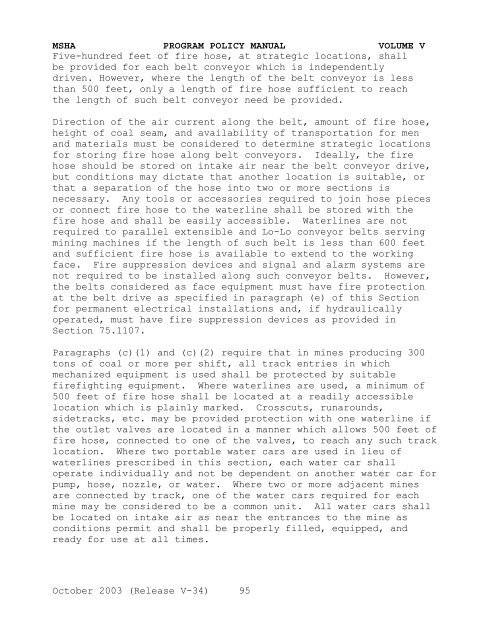Program Policy Manual - VOLUME V - Mine Safety and Health ...
Program Policy Manual - VOLUME V - Mine Safety and Health ...
Program Policy Manual - VOLUME V - Mine Safety and Health ...
You also want an ePaper? Increase the reach of your titles
YUMPU automatically turns print PDFs into web optimized ePapers that Google loves.
MSHA PROGRAM POLICY MANUAL <strong>VOLUME</strong> V<br />
Five-hundred feet of fire hose, at strategic locations, shall<br />
be provided for each belt conveyor which is independently<br />
driven. However, where the length of the belt conveyor is less<br />
than 500 feet, only a length of fire hose sufficient to reach<br />
the length of such belt conveyor need be provided.<br />
Direction of the air current along the belt, amount of fire hose,<br />
height of coal seam, <strong>and</strong> availability of transportation for men<br />
<strong>and</strong> materials must be considered to determine strategic locations<br />
for storing fire hose along belt conveyors. Ideally, the fire<br />
hose should be stored on intake air near the belt conveyor drive,<br />
but conditions may dictate that another location is suitable, or<br />
that a separation of the hose into two or more sections is<br />
necessary. Any tools or accessories required to join hose pieces<br />
or connect fire hose to the waterline shall be stored with the<br />
fire hose <strong>and</strong> shall be easily accessible. Waterlines are not<br />
required to parallel extensible <strong>and</strong> Lo-Lo conveyor belts serving<br />
mining machines if the length of such belt is less than 600 feet<br />
<strong>and</strong> sufficient fire hose is available to extend to the working<br />
face. Fire suppression devices <strong>and</strong> signal <strong>and</strong> alarm systems are<br />
not required to be installed along such conveyor belts. However,<br />
the belts considered as face equipment must have fire protection<br />
at the belt drive as specified in paragraph (e) of this Section<br />
for permanent electrical installations <strong>and</strong>, if hydraulically<br />
operated, must have fire suppression devices as provided in<br />
Section 75.1107.<br />
Paragraphs (c)(1) <strong>and</strong> (c)(2) require that in mines producing 300<br />
tons of coal or more per shift, all track entries in which<br />
mechanized equipment is used shall be protected by suitable<br />
firefighting equipment. Where waterlines are used, a minimum of<br />
500 feet of fire hose shall be located at a readily accessible<br />
location which is plainly marked. Crosscuts, runarounds,<br />
sidetracks, etc. may be provided protection with one waterline if<br />
the outlet valves are located in a manner which allows 500 feet of<br />
fire hose, connected to one of the valves, to reach any such track<br />
location. Where two portable water cars are used in lieu of<br />
waterlines prescribed in this section, each water car shall<br />
operate individually <strong>and</strong> not be dependent on another water car for<br />
pump, hose, nozzle, or water. Where two or more adjacent mines<br />
are connected by track, one of the water cars required for each<br />
mine may be considered to be a common unit. All water cars shall<br />
be located on intake air as near the entrances to the mine as<br />
conditions permit <strong>and</strong> shall be properly filled, equipped, <strong>and</strong><br />
ready for use at all times.<br />
October 2003 (Release V-34) 95
















